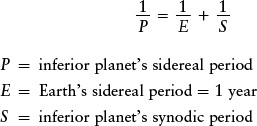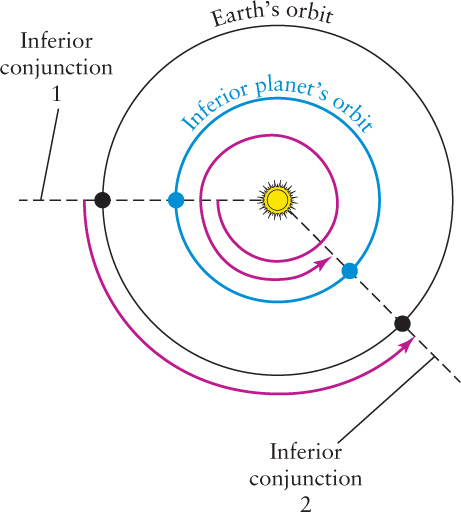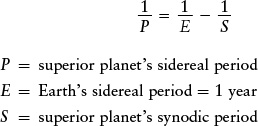TOOLS OF THE ASTRONOMER’S TRADE
Relating Synodic and Sidereal Periods
We can derive a mathematical formula that relates a planet’s sidereal period (the time required for the planet to complete one orbit) to its synodic period (the time between two successive identical configurations). To start with, let us consider an inferior planet (Mercury or Venus) orbiting the Sun as shown in the accompanying figure. Let P be the planet’s sidereal period, S the planet’s synodic period, and E Earth’s sidereal period or sidereal year (see Section 2-8), which Copernicus knew to be nearly 365¼ days.
The rate at which Earth moves around its orbit is the number of degrees around the orbit divided by the time to complete the orbit, or 360°/E (equal to a little less than 1° per day). Similarly, the rate at which the inferior planet moves along its orbit is 360°/P.
During a given time interval, the angular distance that Earth moves around its orbit is its rate, (360°/E), multiplied by the length of the time interval. Thus, during a time S, or one synodic period of the inferior planet, Earth covers an angular distance of (360°/E)S around its orbit. In that same time, the inferior planet covers an angular distance of (360°/P)S. Note, however, that the inferior planet has gained one full lap on Earth, and hence has covered 360° more than Earth has (see the figure). Thus, (360°/P)S = (360°/E)S + 360°. Dividing each term of this equation by 360°S gives
For an inferior planet:


 A similar analysis for a superior planet (for example, Mars, Jupiter, or Saturn) yields
A similar analysis for a superior planet (for example, Mars, Jupiter, or Saturn) yields
For a superior planet:

Using these formulas, we can calculate a planet’s sidereal period P from its synodic period S. Often astronomers express P, E, and S in terms of years, by which they mean Earth years of approximately 365.26 days.
EXAMPLE: Jupiter has an observed synodic period of 398.9 days, or 1.092 years. What is its sidereal period?
Situation: Our goal is to find the sidereal period of Jupiter, a superior planet.
Tools: Since Jupiter is a superior planet, we use the second of the two equations given above to determine the sidereal period P.
Answer: We are given Earth’s sidereal period E = 1 year and Jupiter’s synodic period S = 1.092 years. Using the equation 1/P = 1/E − 1/S,

so

Review: Our answer means that it takes 11.87 years for Jupiter to complete one full orbit of the Sun. This sidereal period is greater than Earth’s 1-year sidereal period because Jupiter’s orbit is larger than Earth’s orbit. Jupiter’s synodic period of 1.092 years is the time from one opposition to the next, or the time that elapses from when Earth overtakes Jupiter to when it next overtakes Jupiter. This synodic period is so much shorter than the sidereal period because Jupiter moves quite slowly around its orbit. Earth overtakes it a little less often than once per Earth orbit, that is, at intervals of a little bit more than a year.